Adrian Collins's Blog, page 118
November 1, 2022
REVIEW: Empire of Exiles by Erin M. Evans
Erin M. Evans’ new book, Empire of Exiles, brings together an ensemble cast with varying motives and personalities in an appealingly bookish setting. As dangerous, historical items are unearthed and a puzzling crime is committed, our unlikely heroes are swept up in a political scheme threatening the very foundation of their society.
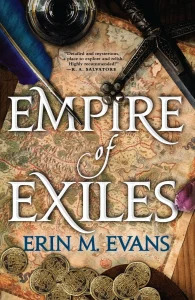 Once there lived a duke armed with a grudge and a clever mind, a duke who orchestrated a coup against the Empire of Semilla and caused the death of thousands. But this duke failed and was put to death, so the empire moved on. Twenty-three years later, an apprentice scribe named Quill arrives in the city on a typical errand: collect old artifacts from the Imperial Archive. Nothing about these artifacts is insignificant, seeing as they were the very instruments the duke used to stage his attempted rebellion. As these objects are gathered, a brutal murder shakes loose one of the duke’s weapons long since lost, and the only reliable witness is Quill. With the appearance of too many coincidental apparitions, Quill must work alongside a group of specialists, an experienced archivist, and a jaded detective to uncover the truth before the empire’s past lays it to rest.
Once there lived a duke armed with a grudge and a clever mind, a duke who orchestrated a coup against the Empire of Semilla and caused the death of thousands. But this duke failed and was put to death, so the empire moved on. Twenty-three years later, an apprentice scribe named Quill arrives in the city on a typical errand: collect old artifacts from the Imperial Archive. Nothing about these artifacts is insignificant, seeing as they were the very instruments the duke used to stage his attempted rebellion. As these objects are gathered, a brutal murder shakes loose one of the duke’s weapons long since lost, and the only reliable witness is Quill. With the appearance of too many coincidental apparitions, Quill must work alongside a group of specialists, an experienced archivist, and a jaded detective to uncover the truth before the empire’s past lays it to rest.
The narrative of Empire of Exiles is broken into two timelines: one focused in the past right after the failed coup, and one in the present, 23 years later. A dual timeline can be risky since there’s a high probability one timeline will warrant more investment than the other. However, Evans does a remarkable job of not only balancing reader investment in both timelines, but also weaving them together to show direct correlations between the past and present. The usage of multiple perspectives solidifies the narrative angle and acts as the spine for Evans’ strongest novel element: her characters. Each character is well-fleshed out, different, and realistic, especially with regard to their internal conflicts and motives. Evans spends almost an equal amount of time on each character in relation to the short page count.
Along with the characters in Empire of Exiles, Evans gives us a broad and epic world. Each place is carefully thought-out with regard to culture, religion, society, and food as well as interactions both political and casual. Arlabecca, the capital of the Imperial Federation of Semillan Protectorates, acts as a melting pot of these different cultures, paralleling the found family aspect between the characters. Where some readers might struggle with the book is in the presentation of the world-building. The narrative will often break off into blocks of important information as opposed to learning about the world through the eyes of a character.
Though it wouldn’t be filed under the grimdark label, fans of the subgenre will appreciate many parts of Empire of Exiles. Evans’ characters range in terms of their moral compass: some are righteous and true, others are burdened with secrets and must risk everything to keep them, but perhaps, the worst are the ones who will do terrible things for the greater good. There are also moments of unexpected darkness, specifically with the magic system. The thematic elements of identity, friendship, justice, and choice will feel familiar to readers, albeit explored in a different way. At the book’s center is a thread about morality and its cost:
“You can’t dress someone up in silks and shower them in gold, and then drive them insane for your own purposes
and still call yourself moral” (260).
Each character will pay a debt by the story’s end. The book wraps up most of the central plot elements while leaving some overarching aspects unanswered for the eventual sequel.
Thank you to Orbit for sending me an ARC of Empire of Exiles to review.
READ EMPIRE OF EXILES BY ERIN M. EVANSThe post REVIEW: Empire of Exiles by Erin M. Evans appeared first on Grimdark Magazine.
October 31, 2022
REVIEW: Eleventh Cycle by Kian N. Ardalan
With its epic worldbuilding, hauntingly beautiful aesthetic, and well-realized protagonists, Eleventh Cycle is a tour de force of grimdark fantasy and a bold statement from emerging indie author Kian N. Ardalan. The novel takes place in the mist-encircled land of Minethria as the prophesied Eleventh Seed is born. This offspring of the Elder King may, perhaps, serve as savior to the mortal beings of this war-torn land.
 Eleventh Cycle achieves Brandon Sanderson-level worldbuilding, but with a murkier tone and a more nuanced execution. Although the name of Ardalan’s series, Mistland, recalls Sanderson’s Mistborn, the world of Eleventh Cycle has more in common with The Stormlight Archive, particularly with how Ardalan introduces multiple races that vilify each other without knowing why they are enemies.
Eleventh Cycle achieves Brandon Sanderson-level worldbuilding, but with a murkier tone and a more nuanced execution. Although the name of Ardalan’s series, Mistland, recalls Sanderson’s Mistborn, the world of Eleventh Cycle has more in common with The Stormlight Archive, particularly with how Ardalan introduces multiple races that vilify each other without knowing why they are enemies.
Despite the similarities, Ardalan’s world is a lot darker than anything in Sanderson’s universe. This is grimdark fantasy after all, and Eleventh Cycle doesn’t shy away from the dark realities of war, reaching a level of despair and brutality on par with R.F. Kuang’s The Poppy War.
What makes Eleventh Cycle so effective is that this darkness is balanced with a big heart. Ardalan shares Sanderson’s talent at creating empathetic, broken characters, bringing a deeply personal focus to a vast, complex world. At its core, Eleventh Cycle is a character-driven fantasy featuring four mortal protagonists living in a land that is indifferent to their struggles.
Ardalan builds deep connections to each of the four protagonists through their first-person narration. We first meet Dalila, a farmer girl with a mysterious ability that leads to conflict with her conservative family. Next is Nora, who escapes abusive parents to become a fierce warrior full of hatred toward the opposing akar race. Eleventh Cycle then shifts perspective to Chroma, an adolescent akar who struggles with finding his place within akar society. Finally, we are introduced to the high-ranking captain Erefiel, who is caught between worlds as a half-human and half-Zerub, a race that blends human and animal anatomies.
Ardalan is a master at developing realistic, relatable characters. As I progressed through Eleventh Cycle, each of the four protagonists took turns being my favorite character. Although they inhabit a world so different from our own, their struggles reflect universal themes of identity, acceptance, friendship, and love.
In addition to the four first-person protagonists, we also read the third-person story of the Eleventh Seed. Despite the glorious prophecies, the Eleventh Seed is just an innocent child trying to understand human emotions and make sense out of this complex, violent world.
The story itself begins as fragments told from these multiple perspectives, allowing us to build emotional connections to each of the individual characters before their plot lines eventually intersect. It’s especially rewarding to see how everything comes together in the latter part of the book, as many of the subtle connections become clear. Ardalan also keeps us guessing through a variety of unexpected plot twists.
Eleventh Cycle is a compulsively readable novel. Despite its nearly 800-page girth, the story flies by quickly. Kian N. Ardalan’s writing has tightened considerably since his previous novel, The Fantastically Underwhelming Epic of a Dead Wizard and an Average Bard, which adopted a more conversational style and walked a thin line between epic fantasy and self-parody. At its best, Eleventh Cycle repeatedly soars to a Mark Lawrence level of eloquence. There is also a tear-jerking line about fading memories that reminded me of my favorite passage from Norwegian Wood by Haruki Murakami.
The novel’s readability is paired with a keen attention to detail in worldbuilding and character development. Kian N. Ardalan has created an expansive world with a rich history and culture. Eleventh Cycle is an immediately enjoyable novel but also rewards multiple rereads, as additional details and connections become clear. I also love its soft magic system, which is the perfect accompaniment to the novel’s mysterious aesthetic.
Eleventh Cycle checks all the boxes of a grimdark masterpiece. It is a stunning achievement, establishing Kian N. Ardalan as one of the most exciting new voices in speculative fiction.
5/5
Read Eleventh Cycle by Kian N ArdalanThe post REVIEW: Eleventh Cycle by Kian N. Ardalan appeared first on Grimdark Magazine.
October 30, 2022
OCTOBER 2022 COMIC BOOK ROUND UP!
It’s the most…spookiest time…of the year.
I know that’s not how the song goes but I’ve never been a big Christmas guy, so I’ve got to make the best I can with what I have and in the world of comics during October we’ve gotten a whole slew of bloody, creepy, weird, and awesome offerings to go over and get excited about. All kinds of books have come out in October, which has made narrowing it down to the little handful we actually get to talk about a serious task. There have been giant events, single issue specials, premiers, finales, and everything in-between you can think of and then some. So that all being said my ghouls and ghosts, grab your shovels and let’s dig in.
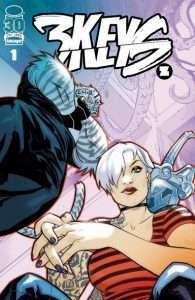 3KEYS #1 (IMAGE)DAVID MESSINA (W/A)
3KEYS #1 (IMAGE)DAVID MESSINA (W/A)This won’t be the first Lovecraftian comic we talk about in this article this month, but it is the premier of what is probably one of the coolest books I’ve gotten my hands on in a while. 3KEYS is inspired by Lovecraft’s tale about the cats of the mythical land of Ulthar, their descendants, and a handful of special mortals who have inherited gifts and curses in equal measure. There’s not a lot at all I can say that won’t spoil it, so I’ll have to suffice with saying Messina is delivering a book that is bloody, ballsy, beautiful to look at and moves along at an exhilarating, breakneck clip that left me wondering where the rest of the book was when I got to the final page. I need more, next month needs to get here already. If you didn’t grab 3KEYS when it first hit the stands, get yourself down to the shop and pray they’ve still got a copy. It’s going to be one to look out for.
READ 3KEYS #1 BY DAVID MESSINA (W/A)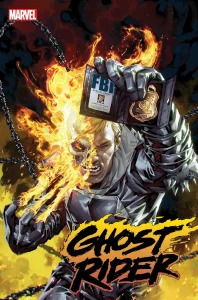 GHOST RIDER #7 (MARVEL)BENJAMIN PERCY (W), CORY SMITH (A)
GHOST RIDER #7 (MARVEL)BENJAMIN PERCY (W), CORY SMITH (A)Alright maybe this guy Percy’s starting to grow on me. Maybe it just took the right character, the right story. His run on Ghost Rider so far? He hasn’t missed a beat, and now with issue seven the story is really starting to push into some serious territory and establish an overarching narrative that’s intriguing as hell. New characters, new enemies. Old heartaches and old nemeses. Percy’s putting poor old Johnny through his paces in Ghost Rider and it’s been a devil of a good time to look at thanks to Smith’s art and the nonstop grindhouse horror action that never really lets up or gives you time to breathe—and the horror’s just getting started for Blaze, with the issue setting up some major stakes for things to come. Like I’ve said before of previous issues: if you’re not already checking out Ghost Rider, it’s way past time to strap in and enjoy the ride.
READY GHOST RIDER # 7 BY BENJAMIN PERCY (W), CORY SMITH (A)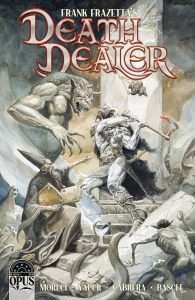 DEATH DEALER #6 (OPUS)
DEATH DEALER #6 (OPUS)MICHAEL MORECI (W), DIEGO YAPUR (A)
I am not going to lie, this was a weird one. The newest tale of Death Dealer has been a brutal, blood-soaked one that delves into some of the darkest places in the realm of fantasy but that’s just always been part of the character’s appeal. It’s all kind of right there in the title. But in the latest installment? Death Dealer takes on the Big Lebows—I mean we meet The Sorcerer. And that’s all I’m going to say. The counterpart to the mysterious, magical Sorceress is definitely not what I was expecting but that doesn’t mean the issue wasn’t the exact kind of asskicking, bloodcurdling good time I’ve come to expect from the series. Honestly, it was a whole hell of a lot of fun and finishes on a page that left me dying to see what’s next.
READ DEATH DEALER # 6 BY MICHAEL MORECI (W), DIEGO YAPU (A)
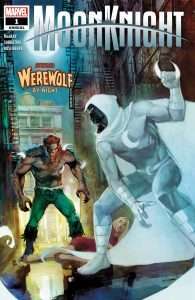 MOON KNIGHT ANNUAL #1 (MARVEL)JED MACKAY (W), FEDERICO SABBATINI (A)
MOON KNIGHT ANNUAL #1 (MARVEL)JED MACKAY (W), FEDERICO SABBATINI (A)I don’t know if I’ve mentioned it before but the current series of Moon Knight isn’t just probably my favorite iteration of the character in a long damn time, but easily one of my favorite on-going series right now. It’s been not just consistently good, but consistently excellent with every issue and the first annual exemplifies every reason why. It touches on Marc’s past, it paves way for his future, it dials in even deeper to one of the most complex characters in comics, serves up awesome action sequences, and overall just tells a fantastic story. It’s an over-sized issue, too, like a good annual should be, and every page is packed with something to pore over. Moon Knight is in damn good hands with its current creative team, and I cannot wait to see what the future has in store for the character. I haven’t been this happy with a book in a long time, and if you’ve been on the fence about the character or the series, it’s not too late to catch up.
READ MOON KNIGHT ANNUAL #1 BY JED MACKAY (W), FEDERICO SABBATINI (A)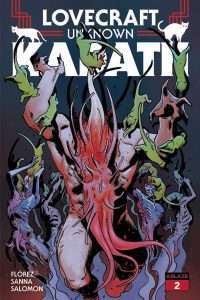 LOVECRAFT: UNKNOWN KADATH (ABLAZE)FLORENTINO FLOREZ (W), JACQUES SALOMON (W)
LOVECRAFT: UNKNOWN KADATH (ABLAZE)FLORENTINO FLOREZ (W), JACQUES SALOMON (W)Told you there was going to be another lovecraftian entry on the list this month. I’m not going to lie, I was kind of on the fence with the first issue of Unknown Kadath but the second has made a believer out of me. You’ve got to understand, though, it’s because out of all the stories that Lovecraft told (love him or hate him), his Randolp Carter/Dreamquest stories were my absolute favorites and I was skeptical whether or not they could be pulled off. Thankfully, I’ve come around to the belief that as far as Carter goes, and this portrayal of the Mythos, it’s in damn good hands and seems to be on track for an interpretation than finds a fine balance between a truthful adaptation and one that stands on its own legs. It helps that the art has a kind of gestural, dreamlike quality to it that genuinely fits the story very well. All in all, I’m super intrigued to see where they go with and how they move forward with Unknown Kadath.
READ LOVECRAFT: UNKNOWN KADATH BY FLORENTINO (W), JACQUES SALOMON (W)The post OCTOBER 2022 COMIC BOOK ROUND UP! appeared first on Grimdark Magazine.
October 29, 2022
REVIEW: Leech by Hiron Ennes
Leech – In Verdira, a brutal winter encroaches as a replacement arrives for a doctor who just died. Both the dead doctor and the replacement are part of The Institute, where doctors are trained; they also both share the same hive-mind. Trained doctors are almost exclusively from The Institute, and the entity inside can take over as many bodies as it believes it needs. But the fact that the replacement has no idea how the original doctor died is cause for concern—what could have happened that the hive mind wasn’t aware of?
 This is the premise of Hiron Ennes’ debut novel Leech, a book that uses The Thing as a starting point—a cold, isolated setting with a parasitic organism. (There’s even an escaped dog being a major contamination risk.) However, the story runs in some very different directions with it. The hive-mind nature of the protagonist makes it not man against alien organism, but two different organisms combating each other.
This is the premise of Hiron Ennes’ debut novel Leech, a book that uses The Thing as a starting point—a cold, isolated setting with a parasitic organism. (There’s even an escaped dog being a major contamination risk.) However, the story runs in some very different directions with it. The hive-mind nature of the protagonist makes it not man against alien organism, but two different organisms combating each other.
The success of any parasite is proportional to its harmlessness. Some are intelligent; they avoid detection, allowing their carriers to lead healthy lives until obsolescence. Fewer, in brilliant acts of symbiosis, foster dependence in the host. But too many are loudmouths and fools, instigating aches, diarrhea, fatigue, bleeding, or other braggadocious symptoms. Most parasites cannot think far enough ahead to maintain the well-being of their host, much less their host’s entire species. Usually, such foresight is not necessary, unless humans are involved. They tend to hold grudges.
Leech’s protagonist as a hive-mind is a great idea, and well-executed. The name the entity gives in the few times in the book it’s asked is Service Before Self though it also becomes clear that that answer isn’t quite the real name. Some of my favorite scenes were as the various incarnations discussed a problem across different parts of the world, describing numerous settings quickly and making it clear that as odd as Verdira is, it’s hardly the strangest part of the world.
The setting of Verdira is great, answering most of the questions a reader might ask in such a way that still leaves plenty open to the imagination. Everything we see is from the point of view of the outsider, so the gaps in information make sense. It lends the book a sense of uncanniness that I really enjoyed. There’s also a detached matter-of-factness, especially when it came to the medical oddities, that reinforced that eeriness. That’s just part of the protagonist’s scientific detachment. For instance, as the protagonist documents information on a parasite it’s found:
Reacts favorably to a nutrient bath of wheat rock, though no notici noticeable growth to date. Specimen is 5 cem, four mims long. Survives at subfreezing temps equally well as at institute standard…
Exposure to animal tissue elicits no response. Porcine and ovine tissue: no response. Canine tissue: no response mild aversion, otherwise no response. Exposure to 0.5 mil of unseparated human blood, courtesy of the Baron: no response. Intensified light: no response.
The mansion itself and its occupants showed that Leech was also inspired by Gothic fiction. An old building with a stern, ill baron who replaces body parts as needed, his cowed but business-like son, the son’s aggressive wife who has birthed mostly normal twins along with a host of oddities, the twins who the Montish believe are the only normal ones there, and the staff. The baron oversees wheatrock mines, which has made him the wealthiest person in the region. They all have strong personalities that clash with each other and the relationship dynamics feel lived-in and realistic.
As Leech continues, the paranoia ramps up as nearly every character displays something that could suggest infection. It comes to a head in one of the creepiest, most unnerving scenes I’ve read. It’s a bloody mix of body horror and vile character dynamics. As the climax hits, paranoia falls away for something both stranger and stronger. It’s a great ending to this fantastic, weird, unsettling novel.
Ready Leech by Hiron EnnesThe post REVIEW: Leech by Hiron Ennes appeared first on Grimdark Magazine.
October 28, 2022
REVIEW: Belladonna by Adalyn Grace
Strangely, it’s the macabre and eerie intimacy with death that feels normal so it’s no extreme statement that gentleness within this casually gothic world would ensnare me as Death has in Adalyn Grace’s Belladonna. Set against a backdrop of poisonous herbology, haunted gardens, reaper magic, and a girl hand in hand with death, the soft moments of kindness in the relationships made Belladonna swirl and bubble perfectly. In the woods of dark fantasy, gothics, and dark academia this one felt minty fresh. Ultimately, yes, this is a gothic but it was hopeful in a dark world of books. More importantly, I had fun reading it.
 Belladonna is like one of those old fantasy movies I would turn on in the middle of the night—masquerade balls, big colorful gowns, and magic tricks. Nothing felt more mesmerizing than sparkle and spectacle in an otherworld where it’s okay to feel things.
Belladonna is like one of those old fantasy movies I would turn on in the middle of the night—masquerade balls, big colorful gowns, and magic tricks. Nothing felt more mesmerizing than sparkle and spectacle in an otherworld where it’s okay to feel things.
“’It’s said that five belladonna berries are all it takes to kill someone’” hooked me but by the end of the chapter, this depressed girl with knives and poison in her pocket got me square in the chest. Signa Farrow is a typical gothic heroine of marriageable age, but with a few key differences. She hates Death, loves poisonous botany, hopes to fall in love, appreciates well-made scones, and has the supernatural ability to visit death regularly.
When her aunt accidentally dies in a mishap, Signa is escorted to her cousin’s gothic estate. Within the sparkled dresses and bubbly drinks, Signa is consumed by murder and poison in the hallowed halls of Thorn Grove. Not long after her mother dies, Blythe is on her death bed with the same symptoms. Suspecting poison, Signa and her gentle companion, Death, resolve to solve the murder and save Blythe’s life.
While a murder mystery at its heart, Belladonna turns into a romance between two lonely people who have only ever known death and loss. What I appreciate most, as with most gothics, is the use of atmosphere for the relationship between Death and Signa. Dead leaves burning red and icy lakes are like dramatic highs that a young woman struggling with the societal norms of 19th century England feels for someone that feels like they belong in her life.
The winter masquerade ball, glittering snowflake masks, and a golden devil horned dancer with hair like starlight will remind readers of a gothic novel dressed in fantasy faerie worlds of Holly Black, the macabre fantasy fate of The Sandman, and the bright underworld of Lore Olympus.
I could feel the scent of deep pine trees, apple in the autumn breeze, the dried blood colors of the autumn leaves, and the sparks that came from a great romance. Trolleys stuffed with sweet sea treats, sticky buns with syrup, and plum jelly pastries are just a few of the Halloween sweets to find in Adalyn Grace’s descriptions.
The ending surprised me with some other promise. It’s that deep intake from discovering a new sparked interest for a new character after a wonderful ending to the first chapter. There’s something new to discover yet.
Monster magic becomes a dark delight in Belladonna.
4 Stars
Read Belladonna by Adalyn GraceThe post REVIEW: Belladonna by Adalyn Grace appeared first on Grimdark Magazine.
October 27, 2022
REVIEW: The Year’s Best Dark Fantasy and Horror Volume Three by Paula Guran
The Year’s Best Dark Fantasy and Horror (Volume 3) is the latest installment in Paula Guran’s annual compilation of top short stories published over the preceding year. Despite its name, this is actually Guran’s thirteenth entry in the series. After publishing the first ten volumes, Guran switched publishers to Pyr Books, and the volume numbering was reset with the new publisher.
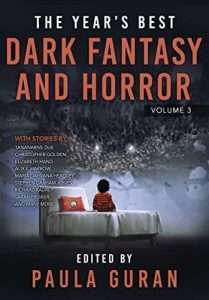 Paula Guran is the two-time Bram Stoker Award-winning editor of fifty short story anthologies and over fifty novels and other collections. Guran’s taste is impeccable: every story in this compilation is a winner. Here I’d like to highlight several of my favorites.
Paula Guran is the two-time Bram Stoker Award-winning editor of fifty short story anthologies and over fifty novels and other collections. Guran’s taste is impeccable: every story in this compilation is a winner. Here I’d like to highlight several of my favorites.
The first story of the collection, “The God Bag” by Christopher Golden, is a beautifully written tale of death and the supernatural. After a lifetime of smoking, the narrator’s mother is dying from cancer. She has a so-called “God bag” in which she places her short prayers written on slips of paper. Normal prayers are written on white paper, while those of a more vindictive variety are written on red. The atmosphere of the story becomes increasingly menacing as the narrator tries to unravel the meaning of the God bag and gain insights into his mother’s deepest desires.
The next story, “The Nag Bride” by A.C. Wise, is also the longest of the collection. Extracted from her recent short story anthology, The Ghost Sequences, “The Nag Bride” concerns a local legend of a bizarre horse-woman ghost. A.C. Wise creates an eerie, disorienting atmosphere as she addresses the long-lasting impact of violence within a family.
Another standout is “Mr. Death” by Alix E. Harrow, which is narrated by a junior grim reaper working for the Department of Death. Having lost his own son, the narrator is haunted by grief. His next assignment involving the impending death of a young child becomes too much for him to bear. Harrow’s story is emotionally devastating, demonstrating the unnerving nature of death, even for someone who works continually with dying souls.
One of the most entertaining stories in The Year’s Best Dark Fantasy and Horror (Volume 3) is “Wolfsbane” by Maria Dahvana Headley. Headley’s story is a dark twist on the Little Red Riding Hood fairy tale, told from the point of view of a sourdough starter. The story strikes a perfect balance between comedy and carnage.
Another story that I particularly enjoyed is “For Sale by Owner” by Elizabeth Hand, which features three middle-aged women who enjoy letting themselves into other people’s houses when no one is at home. The women become entranced by an abandoned house in the woods that is somehow still listed as for sale by owner. Could this be a new HGTV series, perhaps?
The shortest story of The Year’s Best Dark Fantasy and Horror (Volume 3), “Barefoot and Midnight” by Sheree Renée Thomas, is also the most horrifying. Thomas vividly portrays the horrors faced by freed slaves in Memphis after the end of the Civil War with the murder of orphaned schoolchildren by arson. The horrors experienced by freed slaves in the aftermath of the Civil War are a harsh reminder of the racism and hatred faced by so many people during our own time.
The award for most creative narrative format in The Year’s Best Dark Fantasy and Horror (Volume 3) belongs to “Where Oaken Hearts Do Gather” by Sarah Pinsker. Pinsker’s story is written in the style of a Reddit thread with discussion comments added by a variety of contributors. The story focuses on analysis of a traditional English folk ballad with the same title as the story. I particularly enjoyed how each participant contributes a new layer to the story.
These are just a few of the outstanding stories in The Year’s Best Dark Fantasy and Horror (Volume 3). Other featured authors include Stephen Graham Jones (“Refinery Road”), Rebecca Campbell (“The Bletted Woman”), Chimedum Ohaegbu (“And for My Next Trick, I Have Disappeared”), Richard Kadrey (“Across the Dark Water”), Alison Littlewood (“Jenny Greenteeth”), and many more.
While The Year’s Best Dark Fantasy and Horror (Volume 3) is an excellent compilation of stories, I have just one minor quibble. The back of the book promises a story by Zen Cho. However, she does not actually have a story in this volume. This is disappointing, as I really wanted to read her contribution.
The Year’s Best Dark Fantasy and Horror (Volume 3) certainly lives up to its title. Paula Guran has compiled an outstanding collection of short stories, highlighting some of the most exciting voices across dark fiction. Each author brings something fresh and horrific to this compilation, from the quietly ominous hauntings to the darkly humorous adventures. These stories may be brief, but the creeping dread of each tale lurks long after the last page.
4.5/5
Read The Year’s Best Dark Fantasy and Horror Volume 3 by Paula GuranThe post REVIEW: The Year’s Best Dark Fantasy and Horror Volume Three by Paula Guran appeared first on Grimdark Magazine.
October 26, 2022
REVIEW: House of the Dragon- Episode 10 ‘The Black Queen’
House of the Dragon E10 closes out a spectacular first season for the Game of Thrones prequel as the Dance of Dragons finally begins. The battle for the Iron Throne in this season has been one fought with words and miscommunication but now royal blood has been spilled and the dragons are ready to burn Westeros.
House of the Dragon E10 follows the path of the first season, introducing a war that has been created not by monstrous villains, but by people wishing to do what is right by those closest to them, and then getting things wrong. It is a war started by people without all the facts, as proven by the miscommunication between Viserys on his deathbed with his wife Alicent Hightower, just as she was softening towards her old friend Rhaenyra. It paints the two sides of the Targaryen civil war in shades of grey with some characters veering more towards the black or white and offers a realistic complexity to the reasons for war that makes for compelling viewing. It is interesting to see Rhaenyra choose patience when first hearing of her father’s death, in stark contrast to her husband Daemon. She is a calm voice of reason, not willing to burn the world she wishes to rule (something Daenerys also claimed in Game of Thrones). This gets Rhaenys on her side, along with the now recovered Sea Snake Corlys Velaryon. There are talks of peace and demands from Otto Hightower, following his daughter’s instruction as both sides seek power without bloodshed. But this is Westeros, and peace is hard to come by. Rhaenyra sends her sons Luke and Jace to the Starks and Baratheons to confirm their oath to her as the new Queen, but Lord Baratheon has already had a certain one-eyed visitor and he wants revenge…
Prince Daemon speaks to Rhaenyra about the might of dragons. He says that dragons, and not dreams gave the Targaryens the Iron Throne. He counts their number, comparing each side and even goes to sing to a monstrous beast, Vermithor, as he wishes to balance the scales against Aemond’s Vhaghar. And it is dragons who take centre stage at the end of House of the Dragon E10. In one of the most epic scenes brought to screen in fantasy, or any other show, Vhaghar chases Luke and his dragon Arrax through a storm. It is a stunningly shot chase with the lighting perfect for such a scene and the tension ramped up to the max. After an episode of those in power doing their best to avoid an all out war, it is this perfect scene that snaps the thread holding Westeros together and informs the audience that Season 2 of House of the Dragon will be all about the Dance of Dragons. It is heartbreaking because the episode highlights the efforts of those involved to not start a war, or at least do their best to keep bloodshed to a minimum. The expressions on the face of Aemond and Rhaenyra in their final scenes tell the story. Words are not needed. It is a stunning end to what has been a near perfect first season.
House of the Dragon E10 is a prefect finale to a season that can stand up beside the best of Game of Thrones with pride. The writing, acting, music, and visuals are perfect in an episode that provides one of the best scenes ever put together for TV. The first season of House of the Dragon has improved parts of Martin’s Fire and Blood (especially the character of Viserys) and provided a show full of morally grey and complex characters who are about to fight one of the bloodiest wars in the history of TV. Season 2 can’t come soon enough, and the Dance of Dragons will be must-watch TV. This is the benchmark for fantasy. The Witcher, The Wheel of Time, and The Rings of Power are enjoyable and will have their fans (me included!), but they don’t come close to this. House of the Dragon sits on the fantasy throne and it’s there to stay.
The post REVIEW: House of the Dragon- Episode 10 ‘The Black Queen’ appeared first on Grimdark Magazine.
October 25, 2022
REVIEW: Unbound II by Shawn Speakman
Unbound II is Shawn Speakman’s collection of seventeen all-original short stories from eighteen of the most exciting authors in contemporary fantasy and speculative fiction. Speakman plays several roles here, serving as the editor and publisher, as well as the author of the final story in the collection.
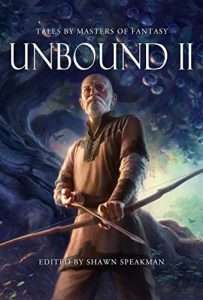 Unbound II is clearly a labor of love for Shawn Speakman, who created this book as a tribute to his late father, Richard Speakman, after his untimely passing in 2018 at the age of 72. That’s an image of Richard Speakman on the beautifully illustrated cover by Todd Lockwood. Unbound II serves as a companion volume to Shawn Speakman’s previous anthology, Unfettered II, which is dedicated to his late mother, Kathy Speakman, likewise featuring her on the cover.
Unbound II is clearly a labor of love for Shawn Speakman, who created this book as a tribute to his late father, Richard Speakman, after his untimely passing in 2018 at the age of 72. That’s an image of Richard Speakman on the beautifully illustrated cover by Todd Lockwood. Unbound II serves as a companion volume to Shawn Speakman’s previous anthology, Unfettered II, which is dedicated to his late mother, Kathy Speakman, likewise featuring her on the cover.
I thoroughly enjoyed the entire Unbound II anthology. For the purposes of this review, I’d like to highlight several of my favorite stories to give you a taste for what’s inside this collection.
Let us begin at the end, with Shawn Speakman’s own contribution, “The Last Arrow of the Autumn Huntsman.” Speakman wrote this story to commemorate his father, who suffered from severe post traumatic stress disorder (PTSD) after serving in the Vietnam War. One of the protagonists of this haunting story, Ryk Oldten, shares this same dark affliction, unable to shake away terrible memories from his past. Speakman provides an authentic representation of PTSD and its impact on family members, who are trying to do their best to understand this affliction and help their loved one. “The Last Arrow of the Autumn Huntsman” is a magnificently heartfelt story that will linger with me for years to come.
The reigning queen of grimdark, Anna Smith Spark, has contributed “A Knight was Once Sent on a Quest by her Master” to Unbound II. Anna Smith Spark has crafted a touching fantasy about a knight, Erenan, with a physical disability that limits the use of her legs. I especially appreciated the loving relationship between Erenan and her horse: as she mounts the horse, they come together to make one unified being. Anna Smith Spark writes with a melancholic beauty and ends on a hopeful note that left me craving more.
As someone who has thoroughly enjoyed watching Mark Lawrence’s new video series on YouTube, “Perfecting the First Page,” it is a joy to see the master at work with his new story, “Solomon.” This is only the fourth short story that Mark Lawrence has published from the point of view of Jorg Ancrath from his Broken Empire series. “Solomon” takes place between the events of Prince of Thorns and King of Thorns. Jorg’s dark humor is in peak form as he is presented with a baby purported to be his own illegitimate child. As usual for Mark Lawrence, “Solomon” is a perfectly crafted story, poetic in its style with a balance between levity and darkness. It is always a thrill to return to the Broken Empire, and I hope Mark Lawrence will follow up with more Jorg stories in the future.
Another standout story is “Shadow’s Daughter” by Jon Sprunk. “Shadow’s Daughter” is set in the same world as his Shadow Saga trilogy and tells the story of Cassie, the daughter of Caim and the Empress Josephine. Cassie loves to sneak out at night to run across the rooftops of the city. As a reader, it is a lot of fun to follow her nighttime adventures. Jon Sprunk has created a great character with Cassie, and I feel like this could be the start of a new series building upon his Shadow Saga trilogy.
Relationships take center stage in “Sandra and Me,” a delightfully weird story by Adrian Tchaikovsky. Tchaikovsky considers the personal and social impact of relationships if they became more inclusive rather than exclusive. “Sandra and Me” is a charmingly quirky and thought-provoking story.
Anna Stephens teaches us a lesson in moral relativism with “Heart-Eater.” I love the world that Anna Stephens has created here in such a small space. But her character work truly stands out, particularly in the relationship between the two main characters, Chen and K’un. “Heart-Eater” is a unique and masterfully crafted short story that will keep you guessing until the end.
On a lighter note, Dyrk Ashton’s contribution, “The True Adventures of Gilgamesh and Enkidu,” is a comedic retelling of the Epic of Gilgamesh. Ashton’s story is fast-paced with many laugh- out-loud moments. My favorite part was his introduction of the Tuckerization Brothers. You’ll need to read the story to find out who has been tuckerized in this fractured version of the ancient Mesopotamian epic.
To my delight, the first story of Unbound II, “Imperial Court” by Brian Herbert and Kevin J. Anderson, takes place in the world of Dune, a favorite series of Richard Speakman. It is especially touching that this story is cowritten by Brian Herbert, the son of Frank Herbert, who carries on his father’s legacy the same way that Shawn Speakman carries on his own father’s legacy with Unbound II. “Imperial Court” focuses on the age-old feud between House Atreides and House Harkonnen, here represented by Willem Atreides and Danvis Harkonnen. The story takes place well before the events of Frank Herbert’s original Dune novel, shortly after the forming of the Spacing Guild as humanity attempts to establish a stable government. There is much to love for Dune fans with the publication of this new short story.
All of the stories in Unbound II are excellent. The other contributors include Saara El-Arifi (“The Shadhavar”), Ken Scholes (“Business in Great Waters”), Jordan Ross (“Moonflower Alchemy”), Peter Orullian (“A Poor Reflection”), Kristen Britain (“Samantha vs. the Shadows in the Basement of the Captain Riddle House”), Kevin Hearne (“Gladys and the Whale”), Django Wexler (“Last of the Red Riders”), Patrick Swenson (“Homecoming”), and Tamora Pierce (“The Sheriff’s Daughter”). Every story here is a winner.
Taken as a whole, Unbound II is both a heartfelt tribute to Shawn Speakman’s father and a showcase for some of the finest talent working in fantasy and speculative fiction today.
5/5
Ready Unbound II by Shawn SpeakmanThe post REVIEW: Unbound II by Shawn Speakman appeared first on Grimdark Magazine.
October 24, 2022
REVIEW: Sins of the Mother by Rob J. Hayes
Two years ago, when I’d finished reading From Cold Ashes Risen, I thought I had finished a brilliant trilogy that would rank among the greats in the grimdark pantheon. I still hold to that belief, but I was pleasantly surprised early this year when Rob J. Hayes released a continuation of Eska’s story in Sins of the Mother. It seems she wasn’t finished with the world just yet.
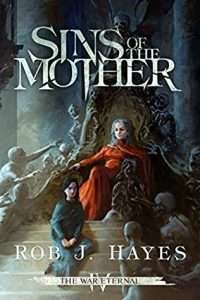 Ten years retired from ruling her kingdom, Eskara Helsene is enjoying her life away from it all. She lives in a village called Wrysom where everyone believes her to be an eccentric old wise woman. Only one little girl calls her “The Corpse Queen” these days, and she’s doing so in jest. The poor thing doesn’t realize how close to the mark she hit with her casual insult.
Ten years retired from ruling her kingdom, Eskara Helsene is enjoying her life away from it all. She lives in a village called Wrysom where everyone believes her to be an eccentric old wise woman. Only one little girl calls her “The Corpse Queen” these days, and she’s doing so in jest. The poor thing doesn’t realize how close to the mark she hit with her casual insult.
”Still, I was old now, and all my life I was reliably informed that age brings wisdom and patience and a bunch of other useless things we tend to ignore in the fires of our youth.”
All is peaceful, until it isn’t. A Sourcerer from a large city comes to announce that trouble is brewing, that all the people in another village have disappeared. She is asked to help learn the reason. Before long, she is found by her adopted sister Imiko, who Eska had left to run her kingdom in her absence. Imiko tells Eska that her daughter Sirileth has left on her own mysterious adventure.
”Drink the amount Imiko had, and your tongue becomes unstuck, and truths you’ve been guarding with good purpose come tumbling out like flies from a bloated corpse.”
Of course, these events are connected, and soon Eska is drawn back in, forced into active status as her identity is eventually revealed to her villagers and she is banished. As Eska accompanies Imiko to find her wayward daughter and discover what strange forces are at work, she is brought full circle back to being the thing that she’d been hiding from all these years.
”Sorry isn’t an apology, it’s just begging to be forgiven without doing the work to warrant it.”
This was a great read, and fit like a comfortable glove after so much time both in the publishing world and in the story itself. What began in book one, Along the Razor’s Edge and continued in The Lessons Never Learned found a return to the narrative decades after From Cold Ashes Risen and despite the gap in time, it’s like we never left Eska’s world. But now the focus isn’t as much on her rise to power as it is those of her heirs to the kingdom, and Eska’s challenge now is to prevent them from becoming the monster that was Eskara Helsene.
”It was still dark all the time, there were no windows anywhere and so everything was lit with lanterns and torches. No matter how many of those you light, the shadows always find corners to dwell in.”
There is another (and final?) entry in The War Eternal series coming out near the end of this year, and it’s safe to say that this reader will be anxious to see what comes next for our Corpse Queen and those close to her.
Read Sins of the Mother by Rob J. HayesThe post REVIEW: Sins of the Mother by Rob J. Hayes appeared first on Grimdark Magazine.
October 23, 2022
REVIEW: Pulling the Wings Off Angels by K.J. Parker
K.J. Parker is a pseudonym for British author Tom Holt, two-time winner of the World Fantasy Award for best novella. Given his impressive track record in the genre, I was excited to read Parker’s latest fantasy novella, Pulling the Wings Off Angels.
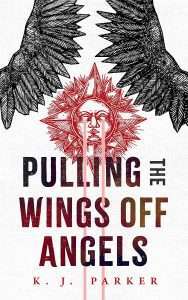 Pulling the Wings Off Angels takes place in the fantasy world of Chosroene, a medieval-inspired land that is only loosely developed for the purposes of the novella. The narrator is a theology student who has lost faith in God, known in Chosroene as the Invincible Sun. Freed from religious morals, the narrator lives a life of debauchery and has racked up a massive debt to a local gangster, Florio.
Pulling the Wings Off Angels takes place in the fantasy world of Chosroene, a medieval-inspired land that is only loosely developed for the purposes of the novella. The narrator is a theology student who has lost faith in God, known in Chosroene as the Invincible Sun. Freed from religious morals, the narrator lives a life of debauchery and has racked up a massive debt to a local gangster, Florio.
As Pulling the Wings Off Angels opens, Florio threatens to torture the narrator for his inability to pay back his debt. But Florio also offers him a way to clear his liabilities by rescuing an angel who had supposedly been kidnapped and imprisoned by the narrator’s impresario grandfather over eighty years ago.
The narrator, of course, does not believe in this legend concerning his grandfather, trusting that he was an upstanding citizen. Given his doubts about the existence of God, he also doesn’t believe in angels.
Imagine the narrator’s surprise, then, when he discovers a glowing angel imprisoned in the basement of a local chapel. The angel’s wings have been clipped, making her unable to escape since, as she explains, angel legs are not actually functional for walking.
To make matters worse, God is unable to help the angel—and is unaware of the angel’s predicament—because she is trapped in a room that is completely hidden to God. We learn that the room was designed by Saloninus, a theology professor who has discovered a means of locally limiting the sight of the Invincible Sun.
The setup of Pulling the Wings Off Angels is meant to raise a paradox about the existence of God in the context of their religion. Most of the discussions in the novella are related to theology, including whether unrepented sins are passed down through the generations and whether it is ever too late for a sinner to repent.
Although K.J. Parker’s writing is outstanding and the novella raises some interesting questions, ultimately Pulling the Wings Off Angels falls flat. The main problem is that the theological paradox raised by the author is in the context of a made-up religion in a fantasy world where the rules seem to have been designed specifically to construct the aforementioned paradox.
Another issue is K.J. Parker’s use of Italian-inspired worldbuilding to represent a fantasy country run by gangsters. This trope has been used in the Venetian-inspired world of Scott Lynch’s Gentleman Bastard series (starting with The Lies of Locke Lamora), as well as Robert Jackson Bennett’s Founders Trilogy (Foundryside). While I enjoyed the Italian representation in these books, I don’t particularly appreciate the Godfather-style typecasting of Italian culture as being full of thieves and mafia-style gangster families.
Despite its interesting premise and excellent writing, Pulling the Wings Off Angels ultimately fails to deliver on its promise to present a compelling theological paradox.
2.5/5
Read Pulling the Wings Off Angels by K.J. ParkerThe post REVIEW: Pulling the Wings Off Angels by K.J. Parker appeared first on Grimdark Magazine.



